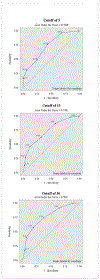Validation of an obstructive sleep apnea symptom inventory in persons with multiple sclerosis
- PMID: 34048308
- PMCID: PMC8627523
- DOI: 10.1177/13524585211013014
Validation of an obstructive sleep apnea symptom inventory in persons with multiple sclerosis
Abstract
Background: Improved screening for obstructive sleep apnea (OSA) could enhance multiple sclerosis (MS) clinical care; yet the utility of current screening tools for OSA have yet to be evaluated in persons with multiple sclerosis (PwMS).
Objectives: The STOP-Bang Questionnnaire is an 8-item screening tool for OSA that is commonly used in non-MS samples. The aim of this study was to assess the validity of the STOP-Bang in PwMS.
Methods: STOP-Bang and polysomnography data were analyzed from n = 200 PwMS. Sensitivity, specificity, positive-, and negative-predictive value (PPV and NPV) were calculated, with receiving operating characteristic (ROC) curves, for each STOP-Bang threshold score, against polysomnography-confirmed OSA diagnosis at three apnea severity thresholds (mild, moderate, and severe).
Results: Nearly 70% had a STOP-Bang score of ⩾3% and 78% had OSA. The STOP-Bang at a threshold score of 3 provided sensitivities of 87% and 91% to detect moderate and severe OSA, respectively; and NPV of 84% and 95% to identify PwMS without moderate or severe OSA, respectively. Sensitivity to detect milder forms of OSA was 76%. The NPV to identify persons without milder forms of OSA was 40%.
Conclusion: The STOP-Bang Questionnaire is an effective tool to screen for moderate and severe OSA in PwMS, but may be insufficient to exclude mild OSA.
Keywords: Multiple sclerosis; STOP-Bang; brainstem; fatigue; obstructive sleep apnea; sleepiness.
Conflict of interest statement
Figures
Similar articles
-
Application value of joint STOP-Bang questionnaire and Epworth Sleepiness Scale in screening for obstructive sleep apnea.Front Public Health. 2022 Sep 29;10:950585. doi: 10.3389/fpubh.2022.950585. eCollection 2022. Front Public Health. 2022. PMID: 36267990 Free PMC article.
-
Evaluation of the Arabic version of STOP-Bang questionnaire as a screening tool for obstructive sleep apnea.Sleep Breath. 2015 Dec;19(4):1235-40. doi: 10.1007/s11325-015-1150-x. Epub 2015 Mar 11. Sleep Breath. 2015. PMID: 25758298
-
STOP-Bang questionnaire: the validation of a Portuguese version as a screening tool for obstructive sleep apnea (OSA) in primary care.Sleep Breath. 2018 Sep;22(3):757-765. doi: 10.1007/s11325-017-1608-0. Epub 2017 Dec 29. Sleep Breath. 2018. PMID: 29285601
-
Use and Performance of the STOP-Bang Questionnaire for Obstructive Sleep Apnea Screening Across Geographic Regions: A Systematic Review and Meta-Analysis.JAMA Netw Open. 2021 Mar 1;4(3):e211009. doi: 10.1001/jamanetworkopen.2021.1009. JAMA Netw Open. 2021. PMID: 33683333 Free PMC article.
-
Validation of the STOP-Bang questionnaire for screening of obstructive sleep apnea in the general population and commercial drivers: a systematic review and meta-analysis.Sleep Breath. 2021 Dec;25(4):1741-1751. doi: 10.1007/s11325-021-02299-y. Epub 2021 Jan 28. Sleep Breath. 2021. PMID: 33507478 Free PMC article.
Cited by
-
Pathways between multiple sclerosis, sleep disorders, and cognitive function: Longitudinal findings from The Nurses' Health Study.Mult Scler. 2023 Mar;29(3):436-446. doi: 10.1177/13524585221144215. Epub 2023 Jan 12. Mult Scler. 2023. PMID: 36633265 Free PMC article.
-
Sleep Problems in Chronic Inflammatory Diseases: Prevalence, Treatment, and New Perspectives: A Narrative Review.J Clin Med. 2021 Dec 23;11(1):67. doi: 10.3390/jcm11010067. J Clin Med. 2021. PMID: 35011807 Free PMC article. Review.
-
The prevalence of obstructive sleep apnea-hypopnea syndrome in patients with multiple sclerosis: a systematic review and meta-analysis.Front Neurol. 2024 Dec 17;15:1444470. doi: 10.3389/fneur.2024.1444470. eCollection 2024. Front Neurol. 2024. PMID: 39741703 Free PMC article.
-
Psychometric Properties of the Pittsburgh Sleep Quality Index (PSQI) in Patients with Multiple Sclerosis: Factor Structure, Reliability, Correlates, and Discrimination.J Clin Med. 2022 Apr 5;11(7):2037. doi: 10.3390/jcm11072037. J Clin Med. 2022. PMID: 35407644 Free PMC article.
-
A Prediction Nomogram of Severe Obstructive Sleep Apnea in Patients with Obesity Based on the Liver Stiffness and Abdominal Visceral Adipose Tissue Quantification.Nat Sci Sleep. 2024 Sep 27;16:1515-1527. doi: 10.2147/NSS.S475534. eCollection 2024. Nat Sci Sleep. 2024. PMID: 39364433 Free PMC article.
References
Publication types
MeSH terms
Grants and funding
LinkOut - more resources
Full Text Sources
Other Literature Sources
Medical




